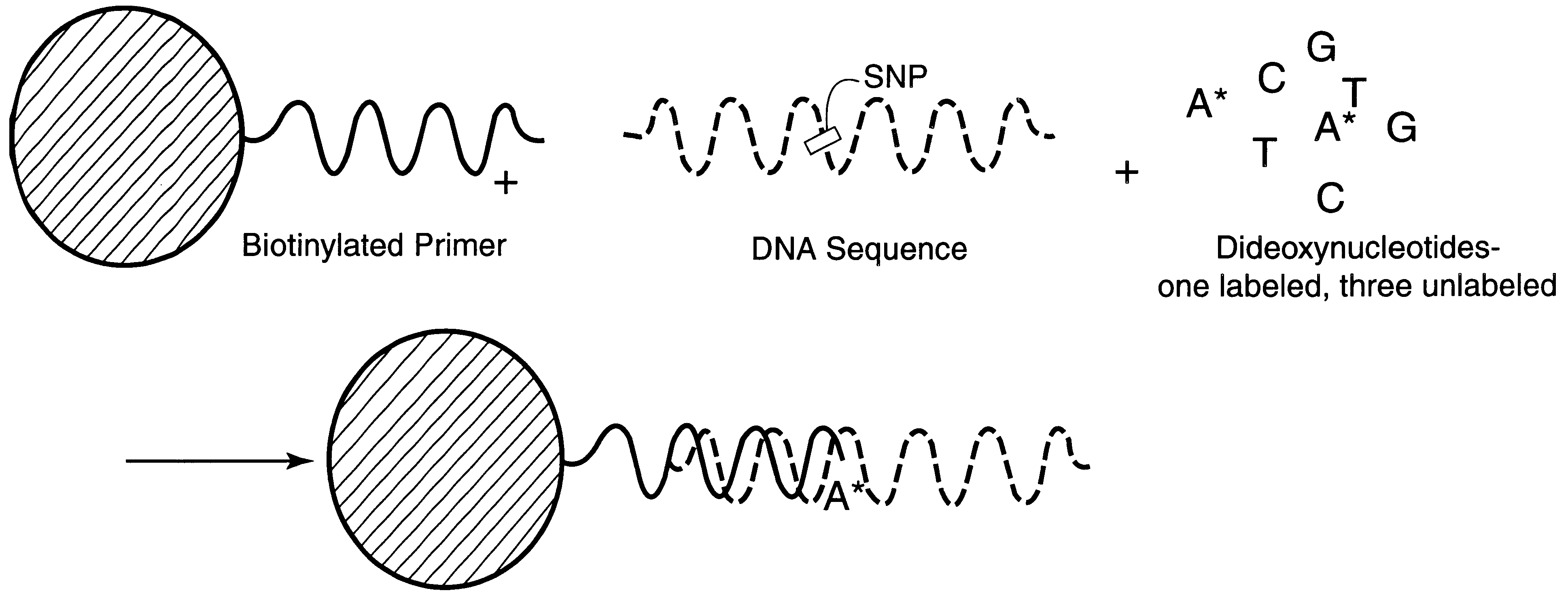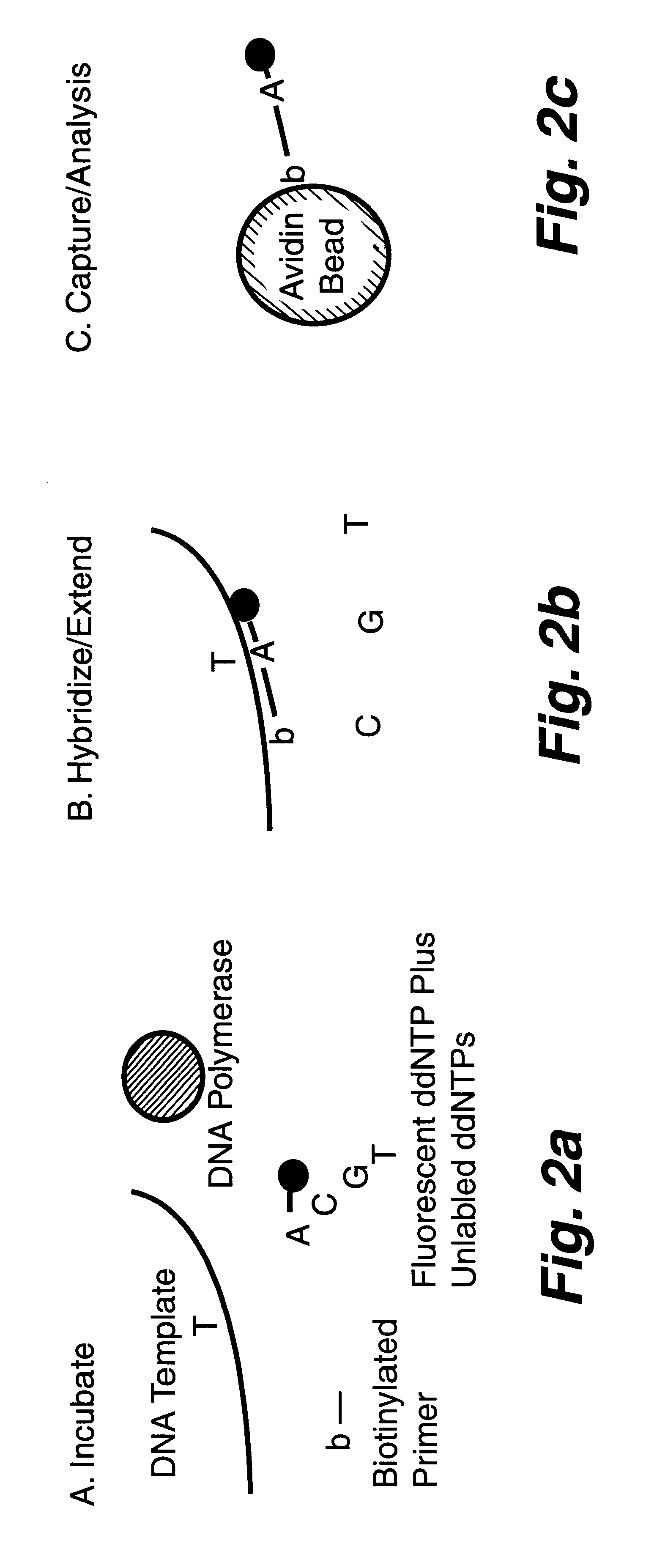DNA polymorphism identity determination using flow cytometry
a flow cytometry and polymorphism technology, applied in biochemistry apparatus and processes, organic chemistry, sugar derivatives, etc., can solve the problems of inability to screen a large number of sites in a large number of individuals, and inability to meet large-scale snp analysis requirements
- Summary
- Abstract
- Description
- Claims
- Application Information
AI Technical Summary
Benefits of technology
Problems solved by technology
Method used
Image
Examples
example 2
Flow Cytometric Minisequencing Using Biotinylated Primers:
FIG. 2a is a schematic representation of microsphere-based minisequencing for flow cytometry similar to that described in FIGS. 1a and 1b hereof, except that soluble biotinylated primers and avidin-coated capture microspheres are used instead of primers which have already been immobilized on the microspheres. FIG. 2b shows the hybridization of the biotinylated primer to the DNA strand to be investigated and the extension of this primer by a single, fluorescent A dideoxynucleotide (assuming that the SNP is a T base) as a result of the DNA polymerase present in the solution. FIG. 2c shows the capture of the extended biotinylated primer onto an avidin-coated microsphere after the hybridized DNA strand is melted, with the subsequent fluorescence analysis using flow cytometry. The sample DNA template is amplified by PCR, and the resulting product treated with shrimp alkaline phosphatase (SAP) and exonuclease I (Exo I) to remove un...
example 3
Flow Cytometric Minisequencing Using Tagged Primers:
FIG. 3a is a schematic representation of a multiplexed microsphere-based minisequencing procedure using soluble sequence-tagged primers and capture probe-bearing microspheres in a similar manner to the minisequencing illustrated in FIGS. 2a and 2b hereof, except that four SNPs have been assumed to be present on the DNA strand. FIG. 3b illustrates the microspheres and the captured extended primers to be analyzed using flow cytometry. The sample DNA template is amplified by PCR, and the resulting product treated with shrimp alkaline phosphatase (SAP) and exonuclease I (Exo I) to remove unconsumed deoxynucleotide triphosphates and PCR primers, respectively. The minisequencing primer, designed to interrogate a specific site on the template DNA, and bearing a 5'-sequence tag is prepared. A capture probe is designed to bind to the 5'-sequence tag of the primer, and is immobilized on microspheres. The capture tag-bearing primer is added t...
example 4
Flow Cytometric Oligonucleotide Ligation Using Immobilized Primers:
FIG. 4a is a schematic representation of microsphere-based oligonucleotide ligation assay using flow cytometry, where a primer immobilized on a microsphere along with fluorescent complementary primers for ligating to the primer which has hybridized to the DNA strand to be investigated in the region of the SNP. FIG. 4b is a schematic representation of the microsphere-attached primer to which the proper fluorescent complement has been ligated after the DNA has been melted away, the flow cytometric determined fluorescence of the microsphere indicating which fluorescent complement has been attached to the DNA strand. The sample DNA template is amplified by PCR, and the resulting product treated with shrimp alkaline phosphatase (SAP) and exonuclease I (Exo I) to remove unconsumed deoxynucleotide triphosphates and PCR primers, respectively. The oligonucleotide ligation primer, designed to interrogate a specific site on the...
PUM
| Property | Measurement | Unit |
|---|---|---|
| total volume | aaaaa | aaaaa |
| volume | aaaaa | aaaaa |
| fluorescent | aaaaa | aaaaa |
Abstract
Description
Claims
Application Information
 Login to View More
Login to View More - R&D
- Intellectual Property
- Life Sciences
- Materials
- Tech Scout
- Unparalleled Data Quality
- Higher Quality Content
- 60% Fewer Hallucinations
Browse by: Latest US Patents, China's latest patents, Technical Efficacy Thesaurus, Application Domain, Technology Topic, Popular Technical Reports.
© 2025 PatSnap. All rights reserved.Legal|Privacy policy|Modern Slavery Act Transparency Statement|Sitemap|About US| Contact US: help@patsnap.com



